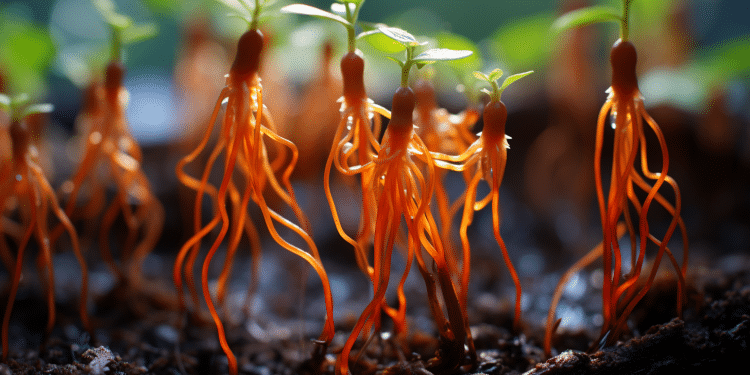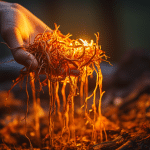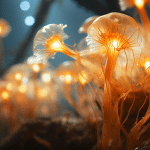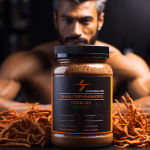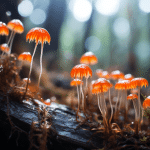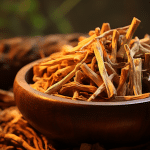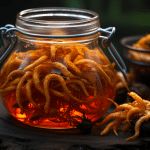We wanted to highlight two methods for growing cordyceps. Which is how to grow them in jars, and also how to use bins.
Here are a few things you’ll need for each method:
| Jar Tech | Bin Tech |
|---|---|
| Cordyceps Liquid Culture | Cordyceps Liquid Culture |
| Paper Towels | Paper Towels |
| 70% isopropyl | 70% isopropyl |
| latex gloves | latex gloves |
| pressure cooker | Rice Cooker / Instant Pot |
| mixing bowl | Parafilm |
| scale scoop | Shoebox size plastic bin |
| mixing spoon | Mixing bowl |
| 12 pint canning jars | Mixing spoon |
| Poly-fil | Scale Scoop |
For those of you that are more visual learners, this is a great instructional video that we like to reference:
Create the Nutrient Broth
For both the Jar and the Bin growing, you will want to begin with making the Nutrient Broth. Nutrient broth is used to water down brown rice, or “matrix” to allow your mushroom mycelium to grow on. Cordyceps grows naturally on insect larvae, so your brown rice and broth substrate would be a nutritious replacement.
Ingredients for nutrient broth:
- 1 gallon coconut water
- 10 grams tapioca starch
- 5 grams magnesium sulfate
- 10 grams multivitamins (crushed)
- 19 grams nutritional yeast or soy peptone
- 11 grams kelp powder
- 3.5 grams gypsum
Combine the dry ingredients: nutritional yeast or soybean peptone, tapioca starch, magnesium sulfate, powdered kelp, crushed multivitamins, and chalk, in a mixing bowl. Add coconut water and stir well.
Extra stock can be stored in fridge up to a week.
Growing Cordyceps With Jars and a Pressure Cooker
Prepare jar lids for inoculation by drilling a single hole into each lid, keeping in mind the hole of appropriate size for the culture syringe. Create the filter by pulling small amounts of polyfil through the holes. Combine 46 ml of the nutritious stock broth with 28g of brown rice per canner, then place canners in the pressure cooker.
Make sure that your pressure cooker is able to achieve 10 pounds per square inch for 45 minutes to one-and-a-half hours for adequate sterilisation. Remove the sterile canners from pressure cookers and let cool to room temperature.
Introduce 1 -2 ml of the liquid culture into each jar via Poly-fil using circular spinning, allowing an even spread of the culture. Sterilize the needles with a flame or ISO before adding the liquid cultures.
How to Grow Cordyceps in Bins and a Rice Cooker
Combine 855 grams of rice with 1 gallon of nutritious stock in the Instant Pot insert.
Getting the two measurements right is crucial to get an adequate fill, as well as limit bacteria growth.
Place insert in Instant Pot and start it on Rice setting.
Inoculating The Bins
Allow the mixture of rice and broth nutrients to cool to room temperature before you start the liquid cultures. Sterilize the mixing spoon and let dry before using.
You will want to perform this process in the most clean area. For best results, use a filtration hood or glovebox. Combine 120-300 milliliters of the liquid culture with the substrate mixture, mixing well. Layer one-half-inch of the mixture on the bottom of the trough, keeping in mind you want to maximize the area your mushrooms will have room to grow.
At this point, you want to have very little airflow into your bin. Lid clips should be sufficient to ensure that the bin is sealed tightly, and there is only a fair amount of airflow, but you might need to wrap a sheet of paraffin over the top. If your bin really has a rubber seal, or an air-tight one, consider adding filtration patches.
Incubation and Harvesting Cordyceps
Substrate incubation must take place in darkness for 3 to 6 days at 65degF. Harvesting must occur at maturity of the fruiting body.
These are located on the top end of elongated “fingers” and are seen in small groups as lumps.
Cordyceps may be stored in ethanol or vinegar to extract and preserve, or dried to be ground into tea, foods, or extracts.
Keep an Eye Out for Contaminants
Calcarisporium cordycipiticola is a common cordyceps contaminant that appears as a white fungus growing over the top of the mycelium of your cordyceps when it has colonized your substrate. It is a parasitic fungus that lives within cordyceps and appears when inoculation temperatures are raised above 68- or 69-degrees F. If you are foraging wild for your cordyceps spores, mites may become an issue.
You can find our favorite capsules, powders, and tincture’s on the following pages of our website and learn more about each individually:
List of The Best Cordyceps Supplement
List of The Best Cordyceps Powder
List of The Best Cordyceps Tincture
List of The Best Cordyceps Mushroom Gummies
Additional Resources:
Does Cordyceps Increase Dopamine?
Updated 10/17/2022
